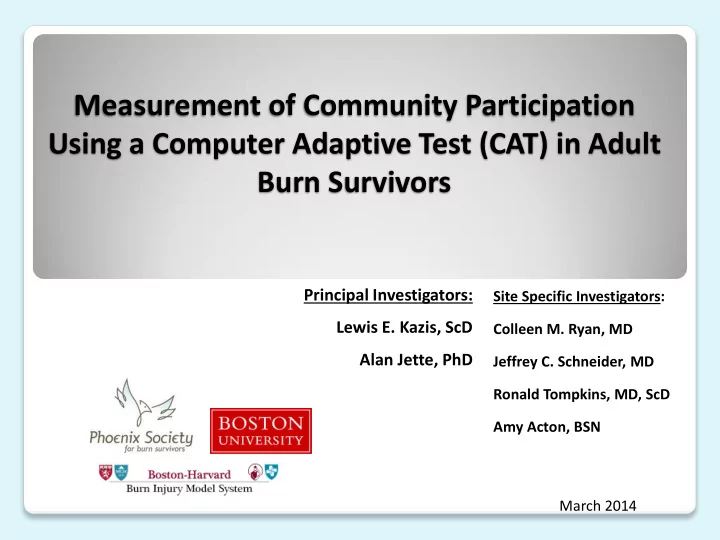

Measurement of Community Participation Using a Computer Adaptive Test (CAT) in Adult Burn Survivors Principal Investigators: Site Specific Investigators: Lewis E. Kazis, ScD Colleen M. Ryan, MD Alan Jette, PhD Jeffrey C. Schneider, MD Ronald Tompkins, MD, ScD Amy Acton, BSN March 2014
Key personnel Principal Investigators: - Lewis E. Kazis , ScD: Professor of Health Policy and Management at Boston University School of Public Health - Alan M. Jette , PhD: Professor of Health Policy and Management at Boston Univesity School of Public Health Site Specific Investigators: - Colleen M. Ryan , MD: Associate Professor of Surgery at Harvard Medical School. Director of Clinical Care, Boston-Harvard BIMS - Jeffrey C. Schneider , MD: Program director, Boston-Harvard BIMS, Assistant Professor, Physical Medicine and Rehabilitation, Harvard Medical School - Ronald G. Tompkins , MD, ScD: Sumner M. Redstone Professor of Surgery at Harvard Medical School - Amy Acton , BSN: Executive director of the Phoenix Society of Burn Survivors Funded by: National Institute of Disability Rehabilitation Research, Award Number: H133A130023 No financial disclosures or conflicts of interest were reported by the personnel of this study
Study goal To develop a specific burn survivors questionnaire for tracking social participation on an individual and community level over time To integrate the latest technology for constructing metrics that are reliable and valid using Computer Adaptive Testing (CAT) To apply CATs to population based studies, clinical trials and patient feedback in real time during the clinic visit
Study goal Specific focus for metrics include the following content: Social interactions: family, friends, relating to strangers Work reintegration: employment and domestic work Personal relationships: intimate and romantic relationships
Significance Questions specifically designed to measure social interactions, work 1. reintegration, and personal relationships are practically non-existing for burn survivors Measure how burn survivors get back to living over time To improve quality of care. Measures are to be applied for outcomes assessment in adults with burns during the recovery process Computer adaptive testing (CAT) will be administered to burn 2. survivors and scored to inform clinicians and patients Dissemination to the burn community Enfranchising the Burn Model System, the Phoenix Society and the larger research and clinical community in the development of the CAT and in its’ application in later year of the project
Study structure • 5 year project, 5 objectives: 1. Create an extensive item pool 2. Field test the item pools for each of the eight domains 3. Develop, calibrate and conduct preliminary psychometric evaluation of the prototype CAT outcome instrument 4. Conduct a pilot study of CAT Disseminate the CAT to the burn community 5.
Study Timeline Create Field test Preliminary item the item Pilot study psychometric Dissemination evaluation pool pool 49-60 37-60 months 1-9 10-24 25-36
Objective 1: Item pool a. Conceptual framework: SOCIAL PARTICIPATION Major life areas and Community, social domestic work and civic life - Work and Employment -Recreation and Leisure -Domestic life -Relating to strangers Intimate Interpersonal relationships relationships -Romantic -Family -Sexual -Informal: friends, neighbors, peers
Objective 1: Item pool b. Comprehensive review of instruments c. Creation of new items > Total number of items: 250 d. Focus groups Burn survivors (March 11 th 2014) Clinicians (March 18 th 2014) Physicians (March 26 th 2014) e. Cognitive testing
Objective 2: Field test the item pools Field test the item pools for each of the eight domains 500 complete questionnaires required to conduct calibration of domains to derive metrics How will burn survivors be chosen? • American Burn Association accredited burn centers • Phoenix Society for burn survivors membership • Boston-Harvard Burn Injury model system center sites
Objective 3: Psychometric evaluation Develop, calibrate and conduct psychometric evaluation of the prototype CAT outcome instrument Three major analytic steps to examine the dimensionality of the outcome domains: Evaluation of response categories for items in each domain Factor analysis to confirm the unidimensionality of items IRT calibration of items
Objective 4: Pilot study Baseline and 6 month follow-up administration of the CAT and YABOQ Convenience sample of 50 burn survivors with recent injuries Examination of the response burden of the CAT compared to YABOQ
Objective 5: Disseminate the CAT Use of the CAT as one of the core data elements for the 4 burn model systems and the Seattle Data Coordinating Center Training and disseminating the CAT into routine clinical care nationally through collaborations with the American Burn Association and Accredited Burn Centers nationally, World Burn Congress and Phoenix Society.
I1, I2, I3, I4, I5, I6, I7, I8, I9, I10, I11, I12, I13, I14, I15, I16, Cat I17, I18, I19, I20, I21, I22, I24, I25, I26, I27, I28, I29, I30, I31, administration I32..
Computer Adaptive Test (CAT) • Not all items are administered to every person • The items that are administered are chosen based on how a person responds to previous items • Items selected from a large item bank
The Process of Building CATs Items from New Modified Items Items from Burn Survivors from existing Items groups Providers questionnaires • Evaluate & Pre-Test Item Pool • Evaluated by experts and burn survivors Calibration Study administered to target Samples 2.5 1.0 2.0 Probability of Response 0.8 Item Information 1.5 0.6 Response 1.0 0.4 Theory 0.5 0.2 (IRT) 0.0 0.0 -3 -2 -1 0 1 2 3 -3 -2 -1 0 1 2 3 Theta Theta Final Item Bank CAT (Calibrated items eval. for Breadth, reliability, validity, and precision) Short Form Instruments
Recommend
More recommend